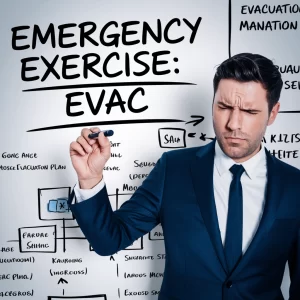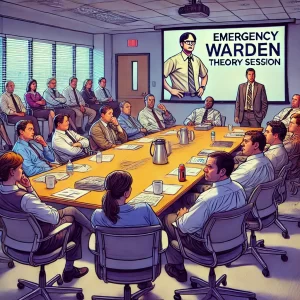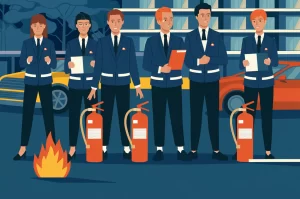Have you ever been in a situation where you thought you were totally prepared, only to find out in the moment that things weren’t as foolproof as you expected? That’s exactly what happened to a childcare centre in Sydney when flash flooding caught them off guard. Despite rehearsing emergency procedures and feeling confident in their planning, key gaps in their emergency response surfaced at the worst possible time.
It’s a scary thought—especially when you’re responsible for young children in an emergency situation. Many childcare services feel underprepared for emergencies because they’re not equipped with the right plans or the full scope of risks. Today, we’re sharing the lessons learned from a real-life emergency and how you can avoid the same pitfalls in your childcare centre.
The Risks of Inadequate Emergency Planning in Childcare Centres
Let’s be honest: most childcare centres rely on basic emergency procedures like lockdowns and evacuations. And while these are essential, they often fall short when the unexpected happens. It’s one thing to prepare for a fire drill or a lockdown, but what happens when the emergency is something no one predicted—like flash flooding?
That’s exactly what we saw in Sydney recently. This centre was smack in the middle of the city, nowhere near a river, and flooding wasn’t even on their radar. But with climate change and unpredictable weather patterns, flash floods can happen just about anywhere. Unfortunately, they weren’t prepared for that.
“It was really scary – I never thought we’d be impacted by flooding here”
The problem wasn’t just the flooding itself, but that their emergency plans didn’t cover this type of incident. They had great procedures for locking down the building and evacuating to a nearby park, but the park was flooded, and lockdown wasn’t an option with water pouring in. This is why relying on only one or two emergency procedures can leave your childcare centre vulnerable.
The Impact of Key Person Failure During Emergencies
We’ve all got that one person in the team who seems to keep everything running smoothly—usually, it’s the director or lead educator. But what happens if they’re not around when disaster strikes? That’s exactly what happened at this Sydney centre. The director, who usually coordinates their emergency response, was away on holiday when the flooding occurred.
The staff were trained and had practiced these emergencies, but the problem was that the director always played a central role in those drills. Without her, the team wasn’t sure who should take the lead. It’s called “key person risk,” and it’s more common than you think in childcare settings.
If your emergency plan relies on just one person, it’s a recipe for disaster. What if they’re sick or on leave when the real emergency hits? You need a broader team trained to take over when necessary, and everyone should know their role in the emergency response. One way to fix this is by forming an emergency management committee, but we’ll dive into that later.
Why a Comprehensive Emergency Risk Assessment is Critical
Here’s where many childcare centres trip up—they assume certain risks won’t apply to them. I mean, who expects flash flooding in the middle of a busy suburb? But in recent years, Sydney has seen more and more incidents of extreme weather, and it’s not just happening by rivers or low-lying areas.
A proper emergency risk assessment would have identified flooding as a potential hazard for this centre. It might not have been their first concern, but an assessment would have helped them realize that any area can be prone to flash floods in the right conditions. And once they’d identified it, they could’ve put plans in place to manage it—like designating an indoor assembly area or making connections with nearby businesses that could offer temporary shelter.
Without this risk assessment, they were left scrambling for a safe place to take the kids when their usual evacuation point was submerged. A simple step like evaluating potential risks could have made a world of difference.
How an Emergency Management Committee Can Reduce Key Person Risk
So how do we prevent key person risk? Simple: don’t let everything fall on one person’s shoulders. That’s where an emergency management committee comes in. It sounds formal, but it’s really just a way of spreading responsibility so that multiple staff members are equipped to handle an emergency.
In the Sydney case, the director’s absence created confusion, but if there had been a committee in place, other staff would have known exactly who was in charge and what to do. The committee can meet regularly to review emergency procedures, organize drills, and ensure everyone stays up-to-date on their roles.
And it doesn’t have to be complicated! Even a small centre can have two or three staff members trained to lead during emergencies. The goal is to reduce reliance on one key person and create a team that can handle a crisis, no matter who’s there that day.
Lessons Learned from Real-life Emergency Incidents in Childcare
Looking back on the Sydney flash flood, there are some clear lessons to be learned. First, relationships matter. The staff at this centre were lucky to have a good relationship with a nearby business that offered their second floor as a temporary safe space for the children. Without that connection, they would have been stuck figuring out where to go while the water rose.
Second, adaptability is key. Even though their usual evacuation site was flooded, the team was able to think on their feet and find a safer alternative. But imagine how much easier that would have been if their emergency plan had accounted for flooding in the first place.
Finally, communication with parents is critical. Once the children were safe, the staff quickly updated parents about the situation, giving them peace of mind during a stressful time. Keeping parents informed during an emergency can make all the difference. Without a doubt, the need to improvise a plan on the spot, combined with the added stress of the key coordinator being absent, severely affected the staff’s ability to communicate with parents, leading to delays. When you’re forced to create a plan in real time, parents are left in the dark until you can provide updates.
Make Your Childcare Centre Safer: Start Planning for Emergencies Now
Emergencies are unpredictable, but they don’t have to be overwhelming. With a proper emergency risk assessment and expert guidance from a team like Emertrix, your childcare centre can be ready for any challenge. Don’t let key person risk or overlooked hazards leave your team unprepared. By working with professionals who understand both Sydney and the childcare industry, you can confidently safeguard your centre, your staff, and the children in your care.
Take the first step towards a safer future by booking a free 15-minute video call with one of our emergency planning experts. It’s a quick, easy way to get personalized advice on how to improve your centre’s emergency readiness.






